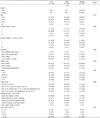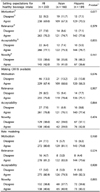1. Office of the Surgeon General (US). Bone Health and Osteoporosis: a Report of the Surgeon General. Rockville (MD): Office of the Surgeon General;2004.
2. Grossman JM. Osteoporosis prevention. Curr Opin Rheumatol. 2011; 23:203–210.

3. Golden NH, Abrams SA. Committee on Nutrition. Optimizing bone health in children and adolescents. Pediatrics. 2014; 134:e1229–e1243.

4. Wallace TC, Reider C, Fulgoni VL 3rd. Calcium and vitamin D disparities are related to gender, age, race, household income level, and weight classification but not vegetarian status in the United States: analysis of the NHANES 2001-2008 data set. J Am Coll Nutr. 2013; 32:321–330.

5. Nicklas TA, Qu H, Hughes SO, Wagner SE, Foushee R, Shewchuk RM. Prevalence of self-reported lactose intolerance in a multi-ethnic sample of adults. Nutr Today. 2009; 44:222–227.

6. Larsson SC, Orsini N, Wolk A. Dietary calcium intake and risk of stroke: a dose-response meta-analysis. Am J Clin Nutr. 2013; 97:951–957.

7. Reicks M, Degeneffe D, Ghosh K, Bruhn C, Goodell LS, Gunther C, Auld G, Ballejos M, Boushey C, Cluskey M, Misner S, Olson B, Wong S, Zaghloul S. Parent calcium-rich-food practices/perceptions are associated with calcium intake among parents and their early adolescent children. Public Health Nutr. 2012; 15:331–340.

8. Larson NI, Story M, Wall M, Neumark-Sztainer D. Calcium and dairy intakes of adolescents are associated with their home environment, taste preferences, personal health beliefs, and meal patterns. J Am Diet Assoc. 2006; 106:1816–1824.

9. Lee S, Reicks M. Environmental and behavioral factors are associated with the calcium intake of low-income adolescent girls. J Am Diet Assoc. 2003; 103:1526–1529.

10. Vue H, Reicks M. Individual and environmental influences on intake of calcium-rich food and beverages by young Hmong adolescent girls. J Nutr Educ Behav. 2007; 39:264–272.

11. Cluskey M, Auld G, Edlefsen M, Zaghloul S, Bock MA, Boushey CJ, Bruhn C, Goldberg D, Misner S, Olson B, Reicks M. Calcium knowledge, concern, and expectations for intake among parents of Asian, Hispanic, and non-Hispanic white early adolescents [Internet]. Raleigh (NC): Department of 4-H Youth Development and Family & Consumer Sciences;2008. cited 2015 October 1. Available from:
http://ncsu.edu/ffci/publications/2008/v13-n3-2008-winter/cluskey-auld-adlefsen-zaghloul-bock-bouskey-bruhn-goldbergnisner-olson-reicks.php.
12. Barr SI. Associations of social and demographic variables with calcium intakes of high school students. J Am Diet Assoc. 1994; 94:260–266. 269

13. Winzenberg T, Hansen E, Jones G. How do women change osteoporosis-preventive behaviours in their children? Eur J Clin Nutr. 2008; 62:379–385.

14. Bagozzi RP, Gopinath M, Nyer PU. The role of emotions in marketing. J Acad Mark Sci. 1999; 27:184–206.

15. Biener L, Ji M, Gilpin EA, Albers AB. The impact of emotional tone, message, and broadcast parameters in youth anti-smoking advertisements. J Health Commun. 2004; 9:259–274.

16. Bates SB, Riedy CA. Changing knowledge and beliefs through an oral health pregnancy message. J Public Health Dent. 2012; 72:104–111.

17. Poggi I. The goals of persuasion. Pragmat Cogn. 2005; 13:297–336.

18. Miceli M, de Rosis F, Poggi I. Emotional and non-emotional persuasion. Appl Artif Intell. 2006; 20:849–879.

19. Kotler P. Marketing Management: Millennium Edition. 10th ed. Upper Saddle River (NJ): Prentice-Hall;1999.
20. Petty RE, Cacioppo JT. The elaboration likelihood model of persuasion. In : Berkowitz L, editor. Advances in Experimental Social Psychology: Vol 19. New York (NY): Academic Press;1986. p. 123–205.
21. Ray ML, Batra R. Emotion and persuasion in advertising: what we do and don't know about affect. In : Tybout AM, Bagozzi RP, editors. Advances in Consumer Research: Vol 10. Ann Arbor (MI): Association for Consumer Research;1983. p. 543–548.
22. Pivonka E, Seymour J, McKenna J, Baxter SD, Williams S. Development of the behaviorally focused fruits & Veggies--More Matters public health initiative. J Am Diet Assoc. 2011; 111:1570–1577.

23. Colchamiro R, Ghiringhelli K, Hause J. Touching hearts, touching minds: using emotion-based messaging to promote healthful behavior in the Massachusetts WIC program. J Nutr Educ Behav. 2010; 42:S59–S65.

24. Tyagi CL, Kumar A. Advertising Management. New Delhi: Atlantic Publishers & Dist;2004.
25. Kreuter MW, Wray RJ. Tailored and targeted health communication: strategies for enhancing information relevance. Am J Health Behav. 2003; 27:Suppl 3. S227–S232.

26. Wirtz JG, Kulpavaropas S. The effects of narrative and message framing on engagement and eating intention among a sample of adult Hispanics. J Nutr Educ Behav. 2014; 46:396–400.

27. Institute of Medicine Committee on Communication for Behavior Change in the 21st Century Improving the Health of Diverse Populations (US). Speaking of Health: Assessing Health Communication Strategies for Diverse Populations. Washington (D.C.): National Academies Press;2002.
28. Ryan RM, Deci EL. Self-determination theory and the facilitation of intrinsic motivation, social development, and well-being. Am Psychol. 2000; 55:68–78.

29. Richards R, Reicks M, Wong SS, Gunther C, Cluskey M, Ballejos MS, Bruhn C, Johnston NP, Misner S, Watters C. Perceptions of how parents of early adolescents will personally benefit from calciumrich food and beverage parenting practices. J Nutr Educ Behav. 2014; 46:595–601.

30. Blakeman R. Integrated Marketing Communication: Creative Strategy from Idea to Implementation. Blue Ridge Summit (PA): Rowman & Littlefield;2014.
31. Vyduna JL, Boushey CJ, Bruhn CM, Reicks M, Auld GW, Cluskey M, Edlefsen M, Misner S, Olson B, Schram J, Zaghloul S. Field-testing a questionnaire assessing parental psychosocial factors related to consumption of calcium-rich foods by Hispanic, Asian, and non-Hispanic white young adolescent children. Ecol Food Nutr. 2016; 55:1–15.

32. Reicks M, Ballejos ME, Goodell LS, Gunther C, Richards R, Wong SS, Auld G, Boushey CJ, Bruhn C, Cluskey M, Misner S, Olson B, Zaghloul S. Individual and family correlates of calcium-rich food intake among parents of early adolescent children. J Am Diet Assoc. 2011; 111:376–384.

33. Yang YJ, Martin BR, Boushey CJ. Development and evaluation of a brief calcium assessment tool for adolescents. J Am Diet Assoc. 2010; 110:111–115.

34. Siris ES, Miller PD, Barrett-Connor E, Faulkner KG, Wehren LE, Abbott TA, Berger ML, Santora AC, Sherwood LM. Identification and fracture outcomes of undiagnosed low bone mineral density in postmenopausal women: results from the National Osteoporosis Risk Assessment. JAMA. 2001; 286:2815–2822.

35. Edlefsen M, Reicks M, Goldberg D, Auld G, Bock MA, Boushey CJ, Bruhn C, Cluskey M, Misner S, Olson B, Wang C, Zaghloul S. Strategies of Asian, Hispanic, and non-Hispanic white parents to influence young adolescents' intake of calcium-rich foods, 2004 and 2005. Prev Chronic Dis. 2008; 5:A119.
36. Borugian MJ, Sheps SB, Whittemore AS, Wu AH, Potter JD, Gallagher RP. Carbohydrates and colorectal cancer risk among Chinese in North America. Cancer Epidemiol Biomarkers Prev. 2002; 11:187–193.
37. Ma J, Johns RA, Stafford RS. Americans are not meeting current calcium recommendations. Am J Clin Nutr. 2007; 85:1361–1366.

38. Zarnowiecki DM, Dollman J, Parletta N. Associations between predictors of children's dietary intake and socioeconomic position: a systematic review of the literature. Obes Rev. 2014; 15:375–391.

39. Wansink B, Pope L. When do gain-framed health messages work better than fear appeals? Nutr Rev. 2015; 73:4–11.

40. Kreuter MW, Oswald DL, Bull FC, Clark EM. Are tailored health education materials always more effective than non-tailored materials? Health Educ Res. 2000; 15:305–315.

41. Quintiliani LM, Carbone ET. Impact of diet-related cancer prevention messages written with cognitive and affective arguments on message characteristics, stage of change, and self-efficacy. J Nutr Educ Behav. 2005; 37:12–19.

42. Wilson BJ. Designing media messages about health and nutrition: what strategies are most effective? J Nutr Educ Behav. 2007; 39:S13–S19.

43. Petty RE, Cacioppo JT. Communication and Persuasion: Central and Peripheral Routes to Attitude Change. New York (NY): Springer-Verlag;1986.
44. Hobbs R, Broder S, Pope H, Rowe J. How adolescent girls interpret weight-loss advertising. Health Educ Res. 2006; 21:719–730.

45. Bandura A. Social Foundations of Thought and Action: a Social Cognitive Theory. Englewood Cliffs (NJ): Prentice Hall;1986.
46. Lustria ML, Noar SM, Cortese J, Van Stee SK, Glueckauf RL, Lee J. A meta-analysis of web-delivered tailored health behavior change interventions. J Health Commun. 2013; 18:1039–1069.

47. Shoemaker PJ, Chang T, Brendlinger N. Deviance as a predictor of newsworthiness: coverage of international events in the US media. In : McLaughlin ML, editor. Communication Yearbook: Vol. 10. London: SAGE Publications;1987. p. 348–365.
48. Kim HS, Lee S, Cappella JN, Vera L, Emery S. Content characteristics driving the diffusion of antismoking messages: implications for cancer prevention in the emerging public communication environment. J Natl Cancer Inst Monogr. 2013; 2013:182–187.








 PDF
PDF ePub
ePub Citation
Citation Print
Print




 XML Download
XML Download